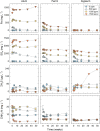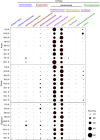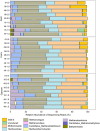Sulfate-based coagulants can suppress methanogenesis in treated oil sands fine tailings
- PMID: 40824510
- PMCID: PMC12363050
- DOI: 10.1186/s12932-025-00104-3
Sulfate-based coagulants can suppress methanogenesis in treated oil sands fine tailings
Abstract
Bitumen extraction from mined oil sands ore generates a large volume of fluid fines tailings (FFT) that must be incorporated into either aquatic or terrestrial reclamation landforms. Mine operators are developing various tailings technologies to accelerate FFT dewatering, including the addition of chemical coagulants and flocculants. However, the impacts of these coagulants and flocculants on biogeochemical processes in treated FFT are not fully understood. We conducted anaerobic batch experiments to examine the influence of different doses (i.e., 0, 500, 1000, and 1500 ppm) of sulfate-based coagulants, including aluminum sulfate (alum) [Al2(SO4)3∙nH2O], ferric sulfate (ferric) [Fe2(SO4)3∙nH2O], and calcium sulfate (gypsum) [CaSO4∙2H2O], on biogenic gas production and microbial communities in treated FFT. Our results show that sulfate addition stimulated microbial sulfate reduction, which inhibited methanogenesis in coagulated FFT relative to experimental controls. Sulfate depletion preceded increased methane production in the 500 ppm gypsum experiment, while larger ferric and alum doses produced higher sulfate concentrations and larger pH decreases. 16 S rRNA sequencing revealed that Comamonadaceae, Anaerolineaceae, and Desulfocapsaceae were the major bacterial families, while Methanoregulaceae and Methanosaetaceae dominated the archaeal families in all treatments. Precipitation of iron(II) sulfides limited dissolved hydrogen sulfide concentrations in experiments where Fe availability was not limited. Our results indicate that addition of sulfate-based coagulants can stimulate microbial sulfate reduction and suppress methanogenesis. However, resumption of methane production following sulfate depletion reveals complex interactions among biogeochemical reaction pathways. Overall, this study demonstrates that biogeochemical cycling of carbon, sulfur, and iron are important considerations for the development and implementation of tailings treatment technologies.
Keywords: Biogeochemistry; Methanogenesis; Oil sands; Sulfate reduction; Treated tailings.
© 2025. The Author(s).
Conflict of interest statement
Declarations. Competing interests: The authors declare no competing interests.
Figures









Similar articles
-
Prescription of Controlled Substances: Benefits and Risks.2025 Jul 6. In: StatPearls [Internet]. Treasure Island (FL): StatPearls Publishing; 2025 Jan–. 2025 Jul 6. In: StatPearls [Internet]. Treasure Island (FL): StatPearls Publishing; 2025 Jan–. PMID: 30726003 Free Books & Documents.
-
Diverse Sulfuriferula spp. from sulfide mineral weathering environments oxidize ferrous iron and reduced inorganic sulfur compounds.Appl Environ Microbiol. 2025 Jul 23;91(7):e0021625. doi: 10.1128/aem.00216-25. Epub 2025 Jun 5. Appl Environ Microbiol. 2025. PMID: 40470961 Free PMC article.
-
Diverse sulfate- and sulfur intermediate- reducing bacteria contributing to annually expanding water anoxia in an oil sands pit lake.J Hazard Mater. 2025 Jul 28;496:139383. doi: 10.1016/j.jhazmat.2025.139383. Online ahead of print. J Hazard Mater. 2025. PMID: 40763520
-
Education support services for improving school engagement and academic performance of children and adolescents with a chronic health condition.Cochrane Database Syst Rev. 2023 Feb 8;2(2):CD011538. doi: 10.1002/14651858.CD011538.pub2. Cochrane Database Syst Rev. 2023. PMID: 36752365 Free PMC article.
-
Measures implemented in the school setting to contain the COVID-19 pandemic.Cochrane Database Syst Rev. 2022 Jan 17;1(1):CD015029. doi: 10.1002/14651858.CD015029. Cochrane Database Syst Rev. 2022. Update in: Cochrane Database Syst Rev. 2024 May 2;5:CD015029. doi: 10.1002/14651858.CD015029.pub2. PMID: 35037252 Free PMC article. Updated.
References
-
- AER (2023) State of Fluid Tailings Management for Mineable Oil Sands, 2022. Alberta Energy Regulator (AER), Government of Alberta, Calgary, Canada, 130 pp
-
- Afzal I, Kuznetsova A, Foght J, Ulrich A, Siddique T (2024) Crystalline iron oxide mineral (magnetite) accelerates methane production from petroleum hydrocarbon biodegradation. Environ Pollut 363:125065. 10.1016/j.envpol.2024.125065 - PubMed
-
- Albakistani EA, Nwosu FC, Furgason C, Haupt ES, Smirnova AV, Verbeke TJ, Lee E-S, Kim J-J, Chan A, Ruhl IA, Sheremet A, Rudderham SB, Lindsay MBJ, Dunfield PF (2022) Seasonal dynamics of methanotrophic bacteria in a boreal oil sands end-pit lake. Appl Environ Microbiol 88:e01455–e01421. 10.1128/aem.01455-21 - PMC - PubMed
-
- Allen EW (2008) Process water treatment in Canada’s oil sands industry: I. Target pollutants and treatment objectives. J Environ Eng Sci 7:123–138. 10.1139/S07-038
-
- Amos RT, Mayer KU, Bekins BA, Delin GN, Williams RL (2005) Use of dissolved and vapor-phase gases to investigate methanogenic degradation of petroleum hydrocarbon contamination in the subsurface. Water Resour Res 41:W02001. 10.1029/2004WR003433
Grants and funding
LinkOut - more resources
Full Text Sources

